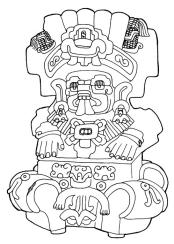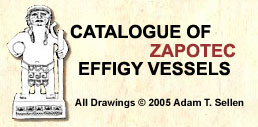| Key: MNC 10-3240 | | Actual Location: National Museum of Cultures, Mexico City, Mexico (warehouse). | | Collection: Fernando Sologuren #508 | | Registration: 10-3240 (number written on the piece). | | Provenance: Mound 5, tomb A (on the roof of the structure), Xoxocotlán, Oaxaca (Sologuren's excavation 1886). | | Measurements: tapa: 28 cm.; base: 19 cm. (47 cm. total) | | Color: Grey clay; the two ears of corn in the headdress are painted in red. | | Chronology: Xoo 600 - 800 AD | | Click to view Chronology | | Reference: Seler's watercolor, 1888; Peñafiel 1893: 53; C.B. Waite, circa 1901, AGN, Mexico; Bauer's photo circa 1900, in König and Kröfges 2001: 131; Seler [1904]1960: 338, fig. 61 (black and white copy of the watercolor); Martínez Gracida 1910: plate 82 | | Comments: According to Martínez Gracida, four of these pieces were found as "merlons" on the tomb's roof. The drawing presented is based on a photo published by Peñafiel (1893: 53). In their work "Urns of Oaxaca", Caso and Bernal (1952: 17, fig. 1) presented the lid with the wrong box. The matching box must be the piece on page 45, fig. 59, of the same work (MNA 6-791). It is worth mentioning that there is a box exhibited at the National Anthropology Museum, under catalog number 6-6956 (INAH 10-522684), which is identical to the box of a piece at the National Museum of Cultures and which must be part of this series of objects. | | Glyphs: Glyph C in the headdress flanked by two ears of corn. | |
| | 
Click to view high resolution in a new window
select this image for review |
